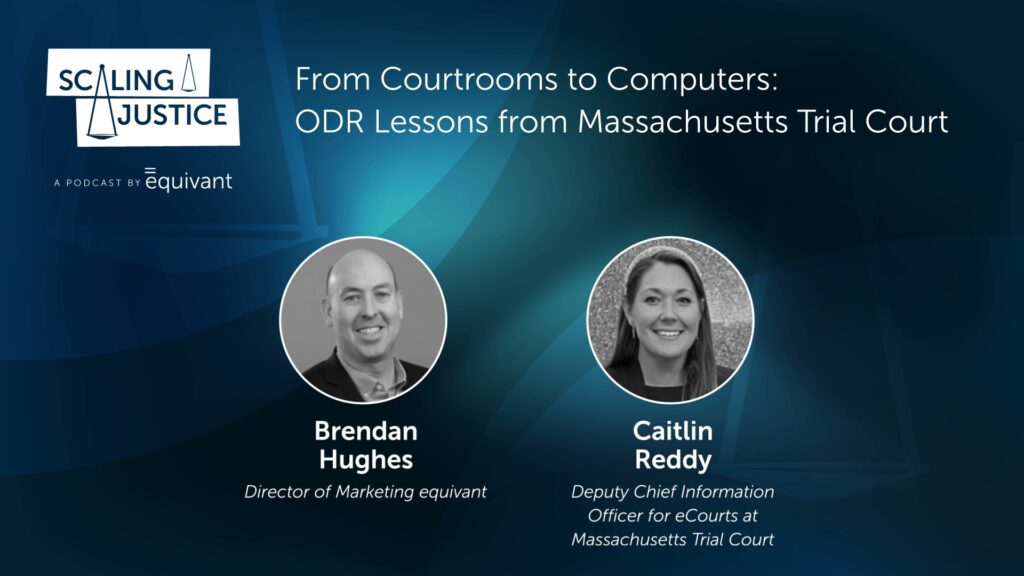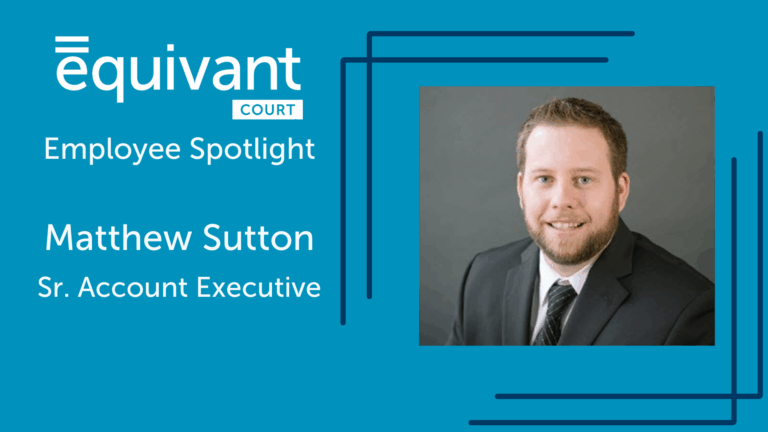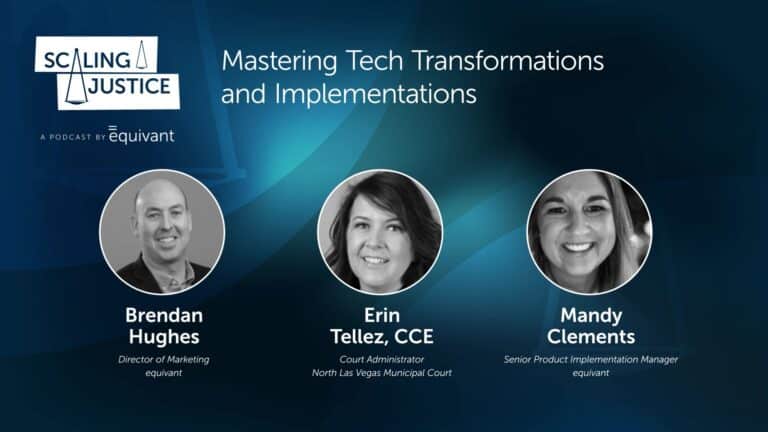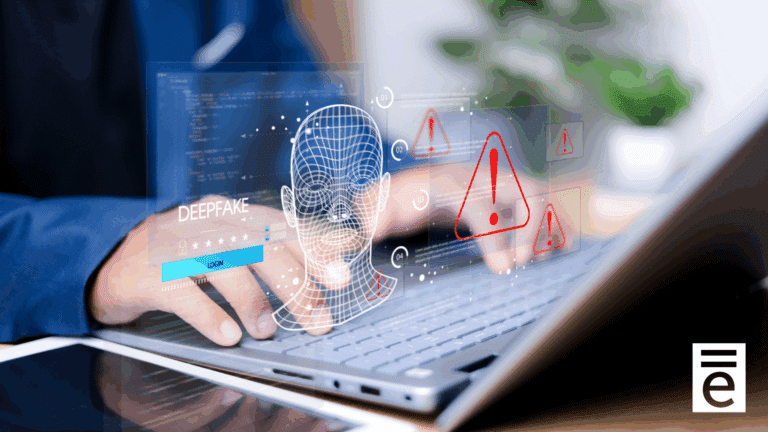In this episode of “Scaling Justice,” we explore the transformative world of Online Dispute Resolution (ODR) with insights from the Massachusetts Trial Court. Discover how technology is revolutionizing the legal landscape by making justice more accessible and efficient. Our expert guest, Caitlin Reddy, Deputy Chief Information Officer for eCourts at Massachusetts Trial Court, shares her experience and lessons learned from implementing ODR. She highlights the challenges and successes of moving from traditional courtrooms to digital platforms. Join us as we explore the future of justice and the innovative solutions that are breaking down barriers and taking us from courtrooms to computers.
Watch on YouTube:
Stream Audio Version on Simplecast.
Scaling Justice Podcast Transcript
From Courtrooms to Computers: ODR Lessons from Massachusetts Trial Court
Brendan Hughes: Hello, welcome to Scaling Justice, a video podcast by equivant that operates at the forefront of the justice space. I’m Brendan Hughes, Director of Marketing at equivant. All of us here at equivant are dedicated to delivering innovative solutions to simplify justice. Today’s podcast focuses on online dispute resolution or ODR for short. It has been a popular topic among court and justice agency leaders. In the constant ongoing drive to improve efficiency in courts or with justice agencies and to make life easier for all stakeholders, from judges, clerks, staff to the community at large, and with the continuous tech advancement over the years. This idea or concept of ODR or online mediation, online diversion has always been at the forefront, but what does that actually mean in practice? How does it get implemented and what does the effectiveness of ODR programs? The answers have varied greatly over time. Fortunately today, we are joined by Caitlin Reddy, the Deputy Chief Information Officer for eCourts with the Massachusetts Trial Court. She’s here to share her experiences as she’s in the process of implementing ODR technology at scale with Mass Trial Courts. We’ll discover more about ODR, what it means in Massachusetts, why they’re using it, as well as lessons learned that could be shared with others that are interested. Let’s learn a little bit more about ODR in real life and not just as a concept. So welcome, Caitlin.
Caitlin Reddy: Thanks Brendan, and happy to be here. Thank you so much for having me.
Brendan Hughes: Great, and before we really dive into the topic, I think it would be great for people to learn a little bit more about you and your past experience, professional and at the court.
Caitlin Reddy: Sure, thanks. So I’ve been with the trial court for almost a decade, which still feels kind of crazy to say in many ways. I feel like I’m still the new kid on the block, but we’re hitting double digit years this year. My professional world before the trial court is really the one that shaped my perspective on technology. That was my first job out of college, and that was at a pretty large e-commerce website, which developed pretty much all the tech that they used in-house. One of my roles there at that company was as a call center quality assurance analyst. So that kind of sparked my love of data analysis and also creating operational efficiencies through technical solutions. I know that sounds corny, but it is true. And while I was working there, I was also going to law school in the evenings. Yeah. And if you would’ve asked me back then if there was any real thread that tied those two experiences together, I would’ve said absolutely not.
They could not have felt more disconnected at the time. But really looking back now, those simultaneous experiences in my day job working with technology, my night life at law school, it’s really that intersection that’s driven my career from there on out. After I graduated law school and passed the bar, I got a job at the Boston Municipal Court, which is one of the seven court departments of the Massachusetts Trial Court, and I worked there for a number of years as a Performance Analyst, and that role was really looking at data and how our courts operated and how we could improve that through kind of analyzing the data and creating efficiencies. From there, I moved to a role on the ecourts team working as an analyst representing the operational needs of the Boston Municipal Court to it as we implemented new solutions. And then a little bit more recently, I became the deputy manager of the eCourts program before last year, becoming the DCIO for eCourts.
Brendan Hughes: Great. Yeah, that’s a varied experience, the very past that does connect well together. Before we kind of dive into the technology part of this, generally when you’re coming up with a solution or some kind of tech enhancement, it’s not just for no reason, right? You mentioned your background as an analyst, so what were some of the driving forces that maybe some pain points or things that led you to believe that an online dispute resolution solution would be important?
Caitlin Reddy: Yeah, absolutely. So just a little bit of background about the Massachusetts Trial Court. We’re statewide and we’re unified, so that means that all of our seven trial court departments, which range from housing court, land court, juvenile court, superior court, they’re all under one common executive office and one common IT department. So the court system itself has offered traditional, what we would call brick and mortar ADR services in person across all of our departments. Many of those services are offered free of charge through our court connected mediation programs. So it’s not something that’s new or unfamiliar, generally mediation or ADR. But in 2021, our access to Justice commission in the state authored and published a report on the recommendation of procuring an online dispute resolution project or program within the trial court. So that’s really been the blueprint for this pilot and for our potential expansion into ODR statewide, we view it as really serving as a compliment to our already existing ADR services, and we think that it’s something that we can use to increase access to justice and also do that through leveraging technology.
Our focus is really on the experience of the self-represented litigants. While we’re a court system, we do recognize that there’s a level of customer service that we should be providing to our court users, and we found, especially in the post pandemic world, that as a society we’re really all in on these virtual processes. We have telehealth, we have remote learning, we have remote working, and the court should be able to match those experiences. So we think that ODR can really mean that someone doesn’t need to commute to a courthouse, they don’t need to take off work or find childcare or even just be in a courtroom or a courthouse, which can feel very intimidating to some people.
Brendan Hughes: Yeah, definitely. Yeah, that’s great to hear. And an interesting perspective of taking something that you guys have learned already from the ADR process and trying to replicate that in the ODR perspective. And so you’ve touched on it a little bit, but I was wondering these concepts of ODR have been around a long time and vary. So maybe a little bit more about what it means in your environment in the mass courts.
Caitlin Reddy: So I took really the definition of what the trial court viewed ODR as from that report from our Access to Justice Commission. And so we’re looking at ODR as an online process in which the parties either by themselves or with the help of a third party neutral or mediator, resolve their disputes to their mutual satisfaction. Key features of the process in Massachusetts are that it’s asynchronous, so the communication can happen at varied times for the parties and that it’s technology-based so that it’s an internet platform that’s replacing that in-person mediation or hearing. Our pilot is going to be focused on small claims cases. Parties can be either self-represented, which the majority of them are in small claims cases generally, or if they have counsel, counsel can participate in the process as well. We’re looking at involving two types of dispute resolution within this one process. Parties will start during a peer-to-peer negotiation phase where in theory they could come to an agreement and file the necessary documents with the court without ever needing the help of that third party neutral or mediator. But if at any point they do want that assistance, the mediator would join and could assist in the asynchronous process of negotiation or mediation, or they could hold virtual mediation via a video conferencing solution, which is embedded within the platform that we’ll be using.
Brendan Hughes: Wow, that’s great. For a pilot. There’s a lot of features there that you’re offering to start with.
Caitlin Reddy: Yeah. We’re also varying some of the elements of the pilot locations. There will be three of them, and those will be across two different departments which have a similar jurisdiction. We have a city and municipal court system and also a district court system. They have the same jurisdiction. It’s just really geography that separates them. So we’ll have one pilot site in our city court, two pilot sites in our district court. So really we’re getting a really great array of geographic locations. One will be a little bit more urban in Boston. One is outside of a bigger city in the western part of our state, and one is right in the middle, so a bit more suburban. And throughout those three different locations, we’re utilizing different processes in terms of, I don’t want to say voluntariness because it’s certainly always voluntary, but two of those we’re going to be considering opt-in where the language that the litigants receive is kind of soft and it offers this program, but it doesn’t mandate it. In one of our locations, it’s going to be an opt-out where users don’t have to participate, but if they don’t participate, they need to notify the court that they’re not planning to participate and provide a reason why. And we’re hoping that we can utilize that to help understand what might be a barrier for folks to use this, should we go into a statewide expansion.
Brendan Hughes: Nice. I’m guessing with your background as an analyst, having all this different varied data is important as you evaluate the effectiveness.
Caitlin Reddy: Effectiveness. Absolutely. Yeah. That’s something that I’m really excited to dig into during our evaluation phase. I want to look at things like how much participation we have and then also the outcomes of these cases. So are they resolving more quickly? Are they reaching settlement agreements before the trial date occurs? We’re also using some more, I’m sorry, qualitative information. So we’ll be looking at surveys that users and our mediation providers get at the end of the process really to determine if they found it easy to use, that it felt fair that an outcome that they were happy with was reached throughout the process. So I’m pretty excited for about a year from now to have more information about what worked and what didn’t in the process.
Brendan Hughes: Yeah. Yeah, I bet. Maybe taking a little bit of a step back just from ODR specifically, but you mentioned through your experience at the court that using technology, leveraging technology is a driver for you for maybe solving some of inefficiencies or making things just easier or better. What’s been your philosophy and how do you try to incorporate technology to maybe solve some of those problems?
Caitlin Reddy: So we view technology as playing a really pivotal role in solving issues, both from kind of a court efficiency perspective, but also access to justice. So technology plays a huge part in how we make the lives of our staff and judges easier streamlining tasks like docketing resulting events, sending notices, scanning fewer documents because those documents are coming in through e-file, not on paper. That allows judges to view them virtually. The public can access them virtually attorneys can access them virtually. All of those kind of elements make their lives easier. But we also recognize that technology is really pivotal in our approach to access to justice. So offering e-filing on those various case types means that people don’t need to come into court to file or go to a post office to file. We have virtual clerks counters that people can access from their home on a Zoom, and we also have new technology like ODR or guided interviews. We’ve been using virtual hearings for certain case types, again, to allow people to not need to participate in a very complex and intimidating process, particularly if you’re representing yourself.
Brendan Hughes: Yeah, that’s great. And leading into the next type of question I’m going to ask you is when you want to select vendors or have people with those technology solutions, what’s your process to evaluate those? Maybe generally, but also specifically with when you launch a new project like the ODR solution?
Caitlin Reddy: Yeah. So with ODR, I started looking personally sort of on my own all the way back in 2022. I made it my mission at the eCourts conference in Las Vegas that year to talk to as many ODR vendors as I could find in the exhibit hall, knowing kind of what the Access to Justice Commission recommended in their report on online dispute resolution made it really easy to narrow the search, focusing on a tool that was sort of geared towards self-represented litigants in an easy to use way. Also considering vendors that had good track record of implementation, and particularly one which interfaced or had already had implementations with equivant, which is our CMS vendor. That was really important as well. Our approach generally to finding the ODR vendor was really similar to other ecourts led initiatives. So coming from sort of a department and working all the way up, I’m a really big proponent of involving the people who are actually going to be interacting with the tool on a day-to-day basis when we select the tool, or at least come up with requirements for selection. So that meant involving folks from the clerk’s offices, from the administrative and legal staff within our departments. We included our trial court, EDR coordinator, and then also representatives from our IT department. And from there it was really about viewing demos, talking to vendors, and finding one which really checked all of the major boxes that we had for requirements.
Brendan Hughes: Great. And leading off of that, involving the end users seems so important because the end solution or the technology solution that you’re bringing to it would probably change processes that they have or change the way they work a little bit, and that’s sometimes not an easy thing. So how do you marry those established processes or workflow with when you bring in a new technology or a new solution? How do you make that work?
Caitlin Reddy: Yeah, so really in this role as the DCIO of ecourts, I’m responsible for presenting a lot of new technology. So I find myself in rooms with leadership or court staff where I’m saying our goal in IT is really not to make things harder or more complicated. And I say that because historically, I don’t know if we in IT generally have always approached changes, particularly changes regarding technology in a thoughtful manner that engaged the people who are actually going to be doing the work. And I think that that’s really important. When we came about to create our project team, we really wanted a crosscut. We’ve got analysts, we’ve got legal counsel, we have administrative staff, we have clerks, we have clerks, office staff. We’re really customizing a solution that fits into an already established process, and we selected a vendor and a product that dovetailed really nicely into our preexisting flow and where it didn’t fit completely, they were willing to work with us to get to a place where it did work.
One example is that it was really important for us to be able to funnel the output of ODR, so those documents that users or mediators would be filing with the court into a preexisting workflow like e-filing. So we worked with our vendor on a solution that will allow us to have that. It wins us major points with the clerk’s office because they’re receiving that work in an already existing flow that requires no new training, and it’s also going to be easier for the providers and the users because it will offer a more seamless experience to file their documents. They won’t have to leave the platform. They’ll be able to file through the platform via a connection to e-filing.
Brendan Hughes: That’s great. So taking a little bit of what they’re doing now, improving on it, but not totally changing everything, which might cause more problems.
Caitlin Reddy: Yeah, exactly.
Brendan Hughes: Great. So now you mentioned before you have these pilots beginning a cross section looking to analyze the data. What are some of your expectations? What are you hoping for? Do you have some kind of established benchmarks or things that you’re looking to get out of the program initially out of the pilot?
Caitlin Reddy: Yeah, so I mean the beauty of the pilot is really that we don’t know what to expect. We don’t know what these results will be. This is a completely new process, and while we do have ADR in the trial court, we’ve never experimented with online dispute resolution. So like I mentioned before, we’re going to be looking at outcomes. Of course, the goal is that we have a really nice amount of volume of folks who were using the tool. We found in other technology initiatives that when we offer something that is virtual, our users tend to opt in. They do want to use technology to make the process easier. So we think that ODR will prove that we’re hopeful that there’s a good amount of volume that’s opting in. I mentioned earlier that we’re looking for more agreements coming in before the trial date. That just reduces some of the work on our staffs and keeps more people at home, not the courthouses. That’s probably a better outcome for most. We’re also looking at a reduction, ideally in time to disposition. So our cases are getting resolved more quickly. That’s showing that there’s an increase in access to justice and the delivery of speedy justice, which is another one of our goals. And we’re hoping that folks report that it’s easy to use, that they found it beneficial, that they felt like they had a role in determining the outcome of their case, some of those benefits that we see with traditional mediation just in a little bit easier to access package.
Brendan Hughes: Tying that back to what you said at the beginning of the community that uses the trial court to be more of a technology focused friendly area. So they’re used to doing telehealth and this will be another way that they would view interacting with the court.
Caitlin Reddy: Yeah,
Brendan Hughes: Exactly. Great. So a lot of great information today, and I’m sure as you probably were seeking out this in 2022 or thinking about this technology solution, others might be doing that or at the same phase that you were back then, what’s some advice that you might give to those people?
Caitlin Reddy: So I really would encourage folks who are going through this process to really engage with your stakeholders first, clearly understand who your stakeholders are, and then start to engage with them to understand what the goals and the intentions are for implementing a tool like ODR. That would be my same advice for any new technology initiative. Once you understand those goals and intentions, you can create a roadmap. Like I said, I am so lucky that hard, hard work was already done through this report that the Access to Justice Commission created. And for projects like these, I am a big fan of a pilot or smaller scale rollout with technology. I found in the court system, there are so many moving parts that even when you think you have done everything right down to the letter, something goes wrong, something pops up, it’s on the first day of your go live, and it throws you for a loop. With the statewide court system, I would much rather address that type of problem in one location or a small handful of location than an entire state that we’re going to have to roll back or pause.
I think that when we do that, it damages our credibility in a way. So I like to try to avoid something like that happening on a large scale. So the other thing that I’ve said kind of repeatedly to folks in Massachusetts when we talk about this project is that we are not blazing a trail. There are many, many jurisdictions that have come before us and implemented ODR. So another piece of advice I would give is to look to those other states and jurisdictions that have already used ODR. There are so many publications or folks from those jurisdictions who are willing to talk to you and share their experiences, share what they’ve learned, their best practices, what worked and what didn’t. We’ve been really lucky to engage with a lot of folks who have been so kind to share that with us, and we’re so thankful for the larger community of people who’ve come before us in these types of projects. So, hopefully, this time next year, we’ll be in a position to do the same and share some of what we’ve learned from our participation in the process.
Brendan Hughes: Great. Yeah. It’s so great to hear the willingness to share best practices and have that community feel, because a lot of these projects can feel daunting and you feel like maybe you’re on your own and maybe that’s not the case. Right?
Caitlin Reddy: No, definitely not. I think kind of the court IT community is one of the best to work with. Again, just so willing to share, so willing to lend their experience and knowledge. It’s been really great.
Brendan Hughes: Well, thank you for joining us today. I appreciate you taking time out of your busy day to participate in this. And good luck in the pilot project.
Caitlin Reddy: Thank you. Thank you so much. I appreciate the opportunity to come on and talk about what we’re doing in Massachusetts.




